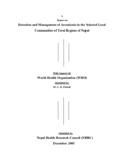Please use this identifier to cite or link to this item:
https://hdl.handle.net/20.500.14356/361Full metadata record
| DC Field | Value | Language |
|---|---|---|
| dc.contributor.author | Nepal Health Research Council (NHRC) | |
| dc.contributor.author | World Health Organization | |
| dc.contributor.author | Pathak, L.R., Dr. | |
| dc.date.accessioned | 2013-01-04T20:04:51Z | |
| dc.date.accessioned | 2022-11-08T10:14:30Z | - |
| dc.date.available | 2013-01-04T20:04:51Z | |
| dc.date.available | 2022-11-08T10:14:30Z | - |
| dc.date.issued | 2005 | |
| dc.identifier.uri | http://103.69.126.140:8080/handle/20.500.14356/361 | - |
| dc.description.abstract | Executive Summary: Arsenic related problem has accelerated to such a extent that has become very much concerned to different authorities to extend various programs like awareness raising programs in the vulnerable areas along with the more depth study for detection and identification of Arsenic contamination cases and degree their health impacts for the better management. As identification and detection of the arsenic related problems are in nascent stage in Nepal, therefore “Detection and Management of Arsenicosis in the selected local communities of Terai region of Nepal” has been designed to detect and manage the cases of Arsenicosis. The study focuses great attention towards: orientation to health workers of 5 selected communities of Terai region, Arsenicosis detection, conductance of disease surveillance of Arsenicosis, awareness raising and organization of national workshop. In order to detect the cases of Arsenicosis and hence initiate the management of these cases, the study was carried out in three distinct phases: Review phases, Field study phase and Data processing and Analysis phase. Fieldstudy phase comprised of Site selection, Field Reconnaissance, Orientation to Health Professionals, Awareness raising to the local communities and Detection and Surveillance of Arsenicosis. The communities have been chosen on the basis of level of vulnerability to Arsenic contamination and very low uncertainty level designated by the study of NASC/ENPHO in 2003.Based on the study report, 3 Village Development Committees (VDCs) of Rautahat and 2 VDCs of Bara were selected as the target communities for the study. The field visit was conducted by four members and was carried out from March to August 2005. The study and survey conducted reveals that in Rautahat, 93.33% of the health workers were not familiar with Arsenicosis cases and that of Bara 70%.The occurrence Arsenicosis among the exposed populationin Rautahat and Bara reveals the majority in Male and majority of population arebeing affected by Keratosis problem. Out of 250 household sampling done, 4.78% of population is affected from Arsenicosis problem. The survey reveals that maximum populations are being affected above 25 years of their age. There is also a chance of prevalence rate to increase in future because of the cumulative nature of Arsenic toxicity. So if not checked in time, there will be huge loss in terms of money, time and labour investment. For this purpose National policy decision making would be the most appropriate. Inorder to stop for health effects caused by the Arsenic contamination, Awareness raising, Orientation and Training programs for the both Health Workers and Communities are necessary. Further health survey should be conducted with the initiation from the Ministry of Health in all hotspot areas and a separate recording system should be developed in all health institution for identification, treatment and monitoring of Arsenic patients. | en_US |
| dc.language.iso | en_US | en_US |
| dc.publisher | Nepal Health Research Council | en_US |
| dc.subject | Arsenicosis | en_US |
| dc.subject | Terai Region | en_US |
| dc.title | A Report on Detection and Management of Arsenicosis in the Selected Local Communities of Terai Regions of Nepal | en_US |
| dc.type | Technical Report | en_US |
| Appears in Collections: | Post Graduate Grant (PG) Reports | |
Files in This Item:
| File | Description | Size | Format | |
|---|---|---|---|---|
| 472.pdf | Full Report. Download | 351.15 kB | Adobe PDF |  View/Open |
Items in DSpace are protected by copyright, with all rights reserved, unless otherwise indicated.
